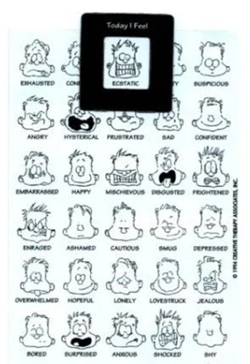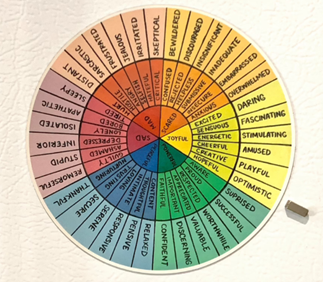Have you ever been around a child who tried to tie their shoes and had a meltdown? Many times, a parent will step in and say something like: “Oh my, it looks like you are pretty frustrated today!” This brilliant bit of parenting not only helps defuse the situation, but it also helps the child identify the big feelings they are having and it’s only one of the many tools adults can use to help their child identify what they are feeling. Here are just a few other ways parents can help children learn to use their words when it comes to developing their emotional vocabulary, something many adults struggle with as well.
Faces Mood Chart
When my children were very small, we had one of these magnets on the fridge and it was a great way to touch base with each other and to take the opportunity to put names to different emotions. We also had lots of fun imitating the faces. Each child could move the frame throughout the day as needed and then we talked about it. Parents can make this a bit more personal by snapping photos of the child (or friends and family) with different expressions to help with visual identification of mood.

Mirror
Showing a child what they look like when they feel a certain way can help them name the emotion and also help them develop emotional intelligence to identify the same emotion on others’ faces. This identification of others’ emotions is an important part of social development and can lead to development and maintenance of friendships.
Words
Sometimes the child might have a general idea of what they are feeling but not have the words to fully express their feelings. You can make a big list or use a wheel that has easily identifiable emotions and then names more with granularity. The important part is to help your child identify feelings as they feel them so they have that immediate word/feeling association.

Read together
Last but not least, as you read books together, you can look at the pictures and try to infer feelings the characters might be experiencing. This is usually pretty easy (and fun!) because children’s book artists create very expressive faces.
Here are some books to assist with developing a child’s emotional vocabulary:
When Sophie Gets Angry—Really, Really Angry by Molly Bang
Lena’s Shoes Are Nervous by Keith Calabrese and Juana Medina
A Is Amazing! Poems About Feelings Edited by Wendy Cooling
Today I Feel Silly & Other Moods That Make My Day by Jamie Lee Curtis and Laura Cornell
Bernice Gets Carried Away by Hannah E. Harrison
My Many Colored Days by Dr. Seuss
- Melody Palmer, Youth Librarian, South Broken Arrow Library